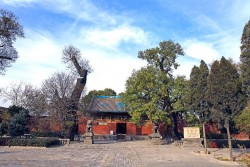You have no items in your shopping cart.


Introducing Wang's Family Compound
Wang’s Family Compound is located 50 km (31 miles) southwest of Pingyao in Shanxi Province. Wang’s Family Compound is one of the largest and best-preserved ancient residential complexes in China. Built during the Qing Dynasty (1644-1912), this sprawling compound covers approximately 250,000 square meters (61.8 acres) and features over 230 courtyards and 1,000 rooms, making it 27 times the size of the renowned Qiao’s Family Compound.
Wang’s Family Compound uniquely blends Northern and Southern Chinese architectural styles. It features both the heavy brick and stone construction of the North and the intricate wood carvings of the South, alongside elaborate carvings and imperial influences. This unique combination reflects the family’s prosperity and high social standing, as they were prominent merchants and officials during the Ming (1368-1644) and Qing dynasties.
Interestingly, the surname Wang (王), meaning “king” or “ruler” in Chinese, was historically used by royals and privileged families. Today, it is the most common family name in China, with over 101.5 million people bearing the name, according to a 2019 analysis of China’s population information system. Although there are several Wang Family Compounds throughout China, this one in Shanxi Province is particularly noteworthy due to its immense scale and historical significance.
Wang's Family Compound Fast Facts
• AKA: Wang’s Grand Courtyard, Wang Family Mansion
•Chinese Name: Wang Jia Da Yuan 王家大院
• Best Time to Visit: Apr, May, Sept & Oct
• Recommended Visiting Hours: 2 - 3 x hours
• Things to Do: Traditional Chinese architecture, folk art.
• Opening Hours: 8:30 to 17:30
• Entrance Fee: CNY55
• Address: Jingsheng Village, Jingsheng Township, Lingshi County, Shanxi Province
What to Expect at Wang's Family Compound
Currently, only two of the colossal courtyards and one of the ancestral halls are open to tourists, comprising a total of 123 smaller courtyards and over 1,100 rooms. The opened areas are the Gaojiaya courtyard, the Red Gate Castle and Wang Clan Ancestral Temple. The three complexes accommodate 123 courtyards, 1118 rooms with an area of 45,000 square meters. Just as important as the scale of the complex is the distinctive architectural style and artistic finishing. As one moves from courtyard to courtyard, one can see an impressive collection of decorative lattice screens and windows, shaped openings between rooms and courtyards, and graceful roofs. The houses and courtyards feature carvings everywhere--in stone, brick, and wood--from the eaves of the houses and ridges of the roofs to window frames, timber joints, and doorways. Paintings, calligraphy, and Qing Dynasty furniture also decorate the houses.
How to Get to Wang Family Compound
• The Wang’s Family Compound is located approx. 50 km (31 miles) away from Pingyao County.
• Charter a car/bus from GoGrandChina to enjoy a hassle free private transfer from Pingyao to Wang's Family Compound.